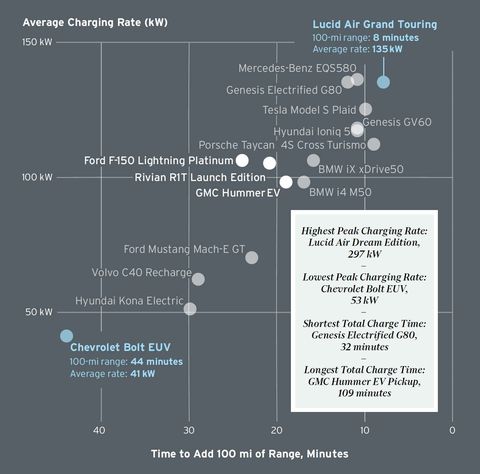Here's How Fast the Latest EVs Can Charge
From the September 2022 issue of Car and Driver.

Welcome to Car and Driver’s Testing Hub, where we zoom in on the test numbers. We’ve been pushing vehicles to their limits since 1956 to provide objective data to bolster our subjective impressions (you can see how we test here).
Charging is complicated, and automakers are part of the problem, making various claims about peak charging rates, time to charge between two states of charge (such as 10 to 80 percent), or time to add a certain number of miles. But there’s no standard metric of comparison.
Huge peak numbers are impressive, but if the power flow falls off a cliff immediately after, it’s not terribly meaningful. What really matters is the average charging rate and how long it takes to add real-world miles.
We test from a 10 to 90 percent state of charge on the fastest equipment an EV can handle. Many of the fastest-charging vehicles require Electrify America’s 350-kW chargers, which sporadically didn’t operate as promised in this year’s testing. So, some results are missing.
In some cases we subbed in a recently tested example for an EV of the Year contender, and we didn’t test every variant powered by the same battery pack. We’ve condensed that data to two figures shown in the chart below: the average charging rate for the entire time plugged in and the time it takes to add 100 real-world highway miles, using the results from our 75-mph range test. Vehicles in the upper-right quadrant excel at both accepting high-power electricity and quickly adding miles.

Infographic by DGFX StudioCar and Driver
Although the Hummer EV had the second-highest peak charge rate, and a decent 98-kW average, its inefficiency and a battery pack that’s more than 60 percent larger than the next-largest means it still took the longest to charge. The fast-charging and efficient Lucid Air wins, taking just eight minutes for a 100-mile top-off. However, in the top cluster of seven stellar performers that can add 100 miles in under 15 minutes, the three that cost less than $100,000 are all from the Hyundai/Kia/Genesis conglomerate. Demonstrating the company’s rapid rate of advancement is that the Ioniq 5 has an average charge rate more than double that of Hyundai’s previous-generation EV effort, the Kona Electric. And it also shows the quirks of fast-charging an EV: The time it takes to charge the Ioniq 5 from 10 to 80 percent is only three minutes longer than the time to go from 80 to 90 percent.




